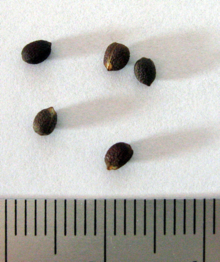Euphorbia leuconeura
| Euphorbia leuconeura | ||||||||||||
|---|---|---|---|---|---|---|---|---|---|---|---|---|

Euphorbia leuconeura - habitus |
||||||||||||
| Systematics | ||||||||||||
|
||||||||||||
| Scientific name | ||||||||||||
| Euphorbia leuconeura | ||||||||||||
| Boiss. |
Euphorbia leuconeura (Greek λευκός (leukós) = white and νευρά (NEURA) = nerve) is a species in the genus spurge ( Euphorbia ) from the family of Euphorbiaceae (Euphorbiaceae). She is a houseplant and rarely as "Madagascar-jewel" (English Madagascar Jewel available) commercially. In the German-speaking world, it is also called spittoon palm. This species is endemic to the northern coastal rainforests of Madagascar .
description
In Euphorbia leuconeura is an erect, usually unbranched stem succulents shrub , the stature heights up to 180 cm reached when the tap root can grow down far enough. The dark green, square to pentagonal trunk has a diameter of 2 to 5 cm and is provided with leaf scars. It's slimmer at the base. The bristly, connected, brown-red edges consist of the stipple spines. These become up to 5 mm long and include the cyathia (pseudo-flowers of milkweed). The plant tends to branch only after a dry period of 4 to 5 weeks, or when it is larger than approx. 50 cm.
The milk juice contains triterpene saponins and diterpene esters, especially ingenols and phorbol esters.
The terminal leaves are lanceolate and about 15 cm long and up to 6.5 cm wide. The leaf stalk is 4 cm long. The leaf blade is dark green at the tip, becoming lighter towards the base. The leaf veins are white (hence the name leuconeura). Stipules are present and similar to cartilage (without chlorophyll and nerve).
Two cyathia are located in the axes of the terminal leaves. They are up to 4 mm long and up to 1.5 mm wide and are greenish white in color. The shape is cylindrical. The stamens protrude far from the cyathium. The ovary is subordinate.
The capsule fruit lignifies when the fruit is ripe and then tears open explosively ( ballochorie ). The spherical seed with a rough surface is thrown away several meters, so this euphorbie belongs to the dehydration spreaders . The seed coat is dark brown, the endosperm whitish.
Multiplication
The fertilization takes place through self-pollination (autogamy). The seeds are spread by a centrifugal mechanism (ballochorie). Propagation occurs almost exclusively generatively via seeds, although broken branches in moist substrate develop roots very slowly and become independent plants.
distribution
Euphorbia leuconeura is endemic to northern Madagascar . The International Union for Conservation of Nature and Natural Resources (IUCN) lists the species on its Red List as "endangered" ( vulnerable ).
Rearing and Use
This species is an undemanding and easy to grow houseplant . Place the plant in the shade to partial shade, avoid direct sunlight and temperatures below 10 ° C. Loses most of the leaves in winter (due to increasing darkness) and re-shoots in spring. The milk juice is poisonous. When grown as a pot plant, this plant needs planters with a height of 24 to 30 cm in order to be able to grow to the normal height of 1.8 m. The plant forms seeds from a height of about 25 cm. Sometimes it is advisable to fertilize the plant a little.
literature
- Urs Eggli: Illustrated Handbook of Succulent Plants: Dicotyledons . 2nd Edition. Springer, Berlin 2007, ISBN 978-3-540-41966-2 , pp. 158 ( Google Books [accessed May 18, 2008]).
- Werner Rauh: Succulent and Xerophytic Plants of Madagascar . tape 1 . Strawberry Press, London 1995, ISBN 978-0-912647-14-2 , pp. 124 f .
- Volker Buddensiek: Succulent Euphorbias . Ulmer, Stuttgart 1998, ISBN 978-3-8001-6634-3 , p. 113 .
Individual evidence
- ↑ Gerd Vogg, Elke Mattes, Axel Polack, Heinrich Sandermann Jr .: Tumor Promoters in Commercial Indoor-Plant Cultivars of the Euphorbiaceae . In: Environmental Health Perspectives . tape 107 , no. September 9 , 1999, PMC 1566443 (free full text).
- ↑ T. Haevermans: Euphorbia leuconeura. In: IUCN 2007. 2007 IUCN Red List of Threatened Species . 2004, accessed June 3, 2015 .

